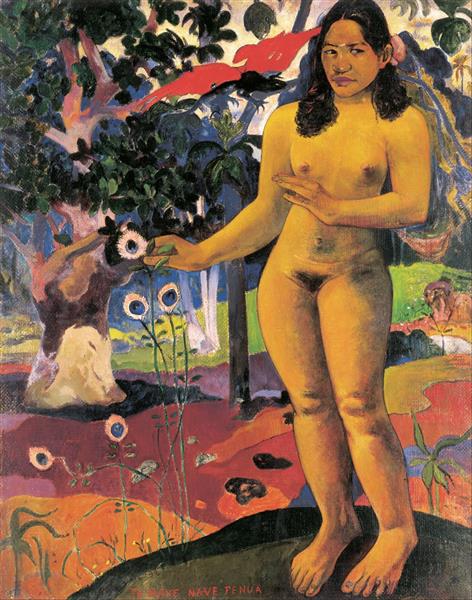Descrição
Paul Gauguin's "Te Nave Nave Fenua" (Enchanting Land), painted in 1892, encapsulates both the essence of the artist's aesthetic quest and his deep appreciation for the cultures that surrounded his artistic life. This painting is a testament to Gauguin's time spent in Tahiti, a place he idealized and which deeply influenced his approach to painting, becoming a spiritual and creative refuge.
The composition of “Te Nave Nave Fenua” suggests a pastoral scene, with a lush landscape unfolding before the viewer. Central to the painting, a strip of land extends into a background where sea and sky meet, highlighting a sense of depth and a horizon that dissolves into the distance. Gauguin employs a distinctive technique of color planes, where shapes not only delineate space but also create a vibrant atmosphere. The intense greens of the vegetation and the deep blues of the sea and sky combine in a play of contrasts that evokes the tropical warmth of Tahiti.
The characters in this work are mostly stylized and simplified silhouettes, in keeping with the synthetic approach to Post-Impressionism that Gauguin adopted during this period. The human figures, which appear to be resting or contemplating nature, are not central to the painting's visual narrative, but rather function as elements that complement the experience of the landscape. This use of the human figure is characteristic of Gauguin, who often sought to represent the human relationship to his environment in a symbolic rather than narrative manner.
Color in “Te Nave Nave Fenua” is instrumental not only in drawing the viewer in, but also in communicating the emotion and meaning of the work. Gauguin uses pure, non-naturalistic colors, a technique that allows him to transcend literal representation and evoke an almost mystical state of mind. The bright, saturated hues reveal the delight the painter experienced during his stay on the island, where everyday life seemed imbued with a sense of happiness and simplicity.
It is interesting to note that "Te Nave Nave Fenua" represents not only a new chapter in Gauguin's life, but also a shift in his style, moving away from the norms of French Impressionism towards a more idealized and personal interpretation of reality. This approach can be seen in other works from this period, such as "Where Do We Come From? What Are We? Where Are We Going?", where simplicity and symbolism prevail.
The title of the work, “Te Nave Nave Fenua,” suggests a sense of wonder and reverence for the earth and the life that surrounds it. Gauguin, through this piece, invites us to explore not only the beauty of nature, but also the spiritual connection that can be found between humanity and its surroundings. This painting is, therefore, not only a charming landscape, but a tribute to life, nature, and the search for the sublime in everyday existence. When contemplating “Te Nave Nave Fenua,” the viewer is transported into a world filled with color and enchantment, where each brushstroke suggests a deep longing for connection and simple joy.
KUADROS ©, a famous painting on your wall.
Hand-made oil painting reproductions, with the quality of professional artists and the distinctive seal of KUADROS ©.
Painting reproduction service with satisfaction guarantee. If you are not completely satisfied with the replica of your painting, we will refund 100% of your money.

